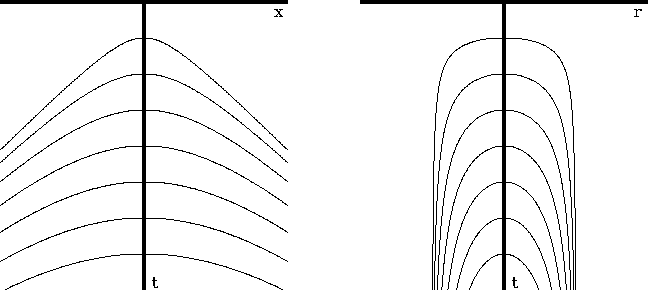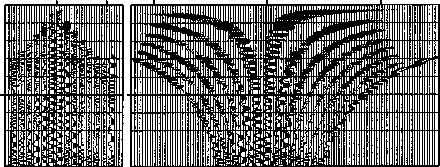Radial trace sections were introduced as an alternative to constant-offset sections. Previously the goal was to achieve a proper migration of nonzero-offset data. We also saw the definition of dip moveout (DMO). DMO simplifies further analysis because after DMO we can analyze gathers assuming that they come from a horizontally layered earth.
A radial trace gather is defined by a deformation of an ordinary gather. Let the ordinary gather be denoted by P(x,t). Let the radial parameter be denoted by r=x/t. Then the radial trace gather P' (r,t) is defined by the deformation P' (r,t) = P(rt,t).
The horizontal location x of the tip of a ray moves according
to ![]() .So in a constant-velocity medium,
the radial trace with a fixed r=x/t contains
all the energy that propagates at angle
.So in a constant-velocity medium,
the radial trace with a fixed r=x/t contains
all the energy that propagates at angle ![]() .
.
The constancy of propagation angle within a radial trace should be helpful in the analysis of multiple reflections. It should also be helpful in compensation for the shot waveform, since the antenna effects of the shot and geophone arrays are time-invariant on each radial trace.
Assuming reflectors at depth zj and constant velocity, hyperbolic travel-time curves are
| |
(2) |
| |
(3) |
 |
The asymptotes, instead of being
along sloping lines ![]() ,are along vertical lines
,are along vertical lines ![]() .The filled region of the (r,t)-plane is rectangular, while the filled
region of the (x,t)-plane is triangular.
.The filled region of the (r,t)-plane is rectangular, while the filled
region of the (x,t)-plane is triangular.
Figure 3 shows a field profile before and after transformation to radial space.
 |
Zero traces were interspersed between live ones
to clarify the shape of the deformation.
To understand this deformation,
it helps to remember that
a field trace is a curve of constant ![]() .
.
An interesting aspect of the radial-trace transformation
is its effect on ground roll.
A simple model of ground roll
is a wave traveling horizontally at a constant rate.
So on a radial-trace gather the ground roll
is found as d.c. (zero frequency) on a few radial
traces near ![]() .Figure 4 shows an approximation to the idealization.
.Figure 4 shows an approximation to the idealization.